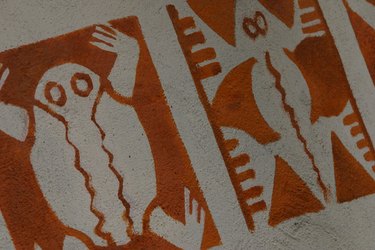
Creating your own stencils allows you to interject your own personality and creative style into your artwork. Wax paper and parchment paper are both suitable for creating stencils, especially for simple patterns and designs. If used carefully, these paper stencils can last for several applications of paint or ink and create crisp, well-defined patterns.
Characteristics
Video of the Day
Used in baking, parchment paper and wax paper have different coatings. The coating on parchment paper is silicone, which gives it a non-stick and heat-resistant surface. Wax paper is coated with either soy wax or paraffin and the wax melts if the paper is heated. Wax paper is more translucent than parchment paper and tears more easily. In making parchment paper, the paper sheets pass through rotating drums that realign the paper fibers to give them strength. Wax paper is less expensive than parchment paper. Both papers burn when exposed to high heat.
Video of the Day
Which One?
As parchment paper is thicker than wax paper, it holds its shape when making a large stencil with many cut-out sections. It is also sturdier and will hold up better if you reuse the stencil several times. The thinner wax paper is more maneuverable for small stencils, particularly non-geometric shapes, or when stenciling into an awkward space. In addition, wax paper's transparency lets you see if paint has seeped under the stencil. You can place either side of the parchment paper stencil and the wax paper stencil on your paper or fabric. Be careful if you use a heat gun to dry your design before you remove the stencil. The papers burn and could catch fire when exposed to high, direct heat.
Alternatives
Freezer paper also makes effective stencils, especially if you're stenciling onto fabric. Freezer paper is thicker than parchment or wax paper and makes a strong stencil. It is dull on one side and shiny on the other. It advantage for making stencils is it temporarily adheres to fabric or paper when you place it shiny side down and iron it. This ensures the stencil attaches firmly to your fabric or paper and paint won'' seep and spoil your design. Experiment with using cards for stencils that you plan on using several times. You can make the card water- and paint-proof by coating it with acrylic medium or a coat of acrylic paint.
Using the Stencil
One of the keys to a clean stenciled design is to firmly attach your stencil to the fabric or paper base. Use masking tape or temporary spray adhesive. Ensure your paint, ink or dye is not too watery and will not run over the base or under the stencil. Although you don't need to use a stencil brush, use a brush with firm bristles. Apply the paint with a firm pouncing motion at right angles to the paper.